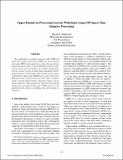Upper bounds on processing loss for wideband, long-CPI space-time adaptive processing
Author(s)
Golowich, Steven E.
DownloadGolowich-2009-Upper bounds on processing loss for wideband, long-CPI space-time adaptive processing.pdf (138.4Kb)
PUBLISHER_POLICY
Publisher Policy
Article is made available in accordance with the publisher's policy and may be subject to US copyright law. Please refer to the publisher's site for terms of use.
Terms of use
Metadata
Show full item recordAbstract
The combination of synthetic aperture radar (SAR) and space-time adaptive processing (STAP) for moving target indication (MTI) radar applications allows the use of long, potentially sparse arrays, wide bandwidths, and long coherent processing intervals (CPIs), all of which enable detection of a greater variety of targets than is possible with traditional systems. In this paper, upper bounds on the signal-to-interference-plus-noise (SINR) loss are derived for post-SAR processing in the presence of three types of impairments: internal clutter motion, volumetric clutter, and antenna backlobes. These bounds are important for both the design and assessment of this type of MTI system, as impairments such as these can influence the entire system architecture.
Date issued
2009-10Department
Lincoln LaboratoryJournal
IEEE Pacific Rim Conference on Communications, Computers and Signal Processing, 2009. PacRim 2009
Publisher
Institute of Electrical and Electronics Engineers
Citation
Golowich, S.E. “Upper bounds on processing loss for wideband, long-CPI space-time adaptive processing.” Communications, Computers and Signal Processing, 2009. PacRim 2009. IEEE Pacific Rim Conference on. 2009. 251-256. © 2009 Institute of Electrical and Electronics Engineers.
Version: Final published version
Other identifiers
INSPEC Accession Number: 10930503
ISBN
978-1-4244-4560-8